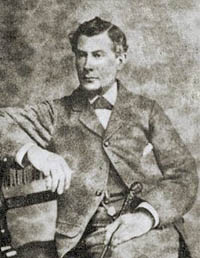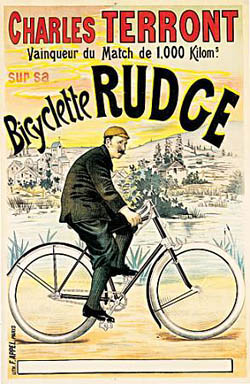First revision: Oct.02, 2012
Last revision: Oct.02, 2012

"Daniel Rudge (1840–June 26, 1880) built the first Rudge High bicycles in 1870". In 1894 it merge with the Whitworth Cycle Co., Ltd. to form Rudge-Whitworth. They made an excellent reputation for themselves over the next twenty years for producing a full range of beautifully made machines with many clever and unique features and ridden by King George V and family. Their road racer were widely used and they diversified into motorcycles in the early 20th century. In 1935 they were bought by EMI (the record company) and under Jack Lauterwasser direction produced some superb top end reacer as well as more mundane machines. EMI however soon decided that cycles were not for them and Rudge was sold to Raleigh in 1943. Raleigh had acquired Humber in 1933 and were to acquire many others after WWII and soon used the Rudge name to badge engineer what were essentially Raleigh machines with Rudge pattern fork crown and chainwheel. Hence there were Rudge versions of the Lenton and of the clubmen. The name was finally killed sometime I think in the early 60s in Britain but may well have been used in export markets later. In Britain the name used on rebadged Montague folders in about 1989."
Hilary Stone on the CR e-mail list, 6.26.00
The Wolverhamton became the third largest source of bicycles in the UK. By 1900 the industry employed 3,000 workers and, through the boom years, was home to more than 200 manufacturers.
One of the most successful companies was launched by Daniel Rudge (1840–1880), landlord of the Tiger Inn on Church Street.
In 1869, the year he won the first cycle race to be held at Molineux—a track later to be eclipsed as the home of the Wolverhampton Wanderers Football Club—Rudge joined with entrepreneurs Walter Phillips and George Price to produce a velocipede designed by Phillips.
The first penny farthings took shape in a shed attached to Rudge’s pub. This arrangement, which presumably allowed for a quick pint between shifts, eventually gave way to a proper workshop on Bishop Street, employing 100.
The restless racer, inspired by the need for speed, set out to improve on the designs of the day. In 1870 he began selling his racing machines, heralded as the best of their kind.
In 1878, the same year he was awarded a gold medal at the London Cycle Show, Rudge took out British Patent No 526 for a revolutionary invention: the adjustable ball bearing hub.

Terront Touts Rudge
Around this time Rudge visited the famous French racer Charles Terront, sojourning in London. Terront was so taken with Rudge’s innovations that he bought one of the inventor’s racing bikes on the spot.
As described on the randonneuring homepage, in 1891 Terront rolled into the annals of cycling by taking first place in the inaugural 1,200 km Paris-Brest-Paris race, now held every four years as the most prestigious of all bicycle randonnées.
With Terront’s endorsement, Bicyclette Rudge found a huge market in France. Rudge himself was one of the first Brits to compete in the French racing scene.
Following Rudge’s untimely death from cancer at 39, the company he built went through several incarnations, in factories around the West Midlands.
The first sale, to George Woodcock of Coventry, included a pension for Rudge’s widow, Mary. A subsequent merger with The Tangent & Coventry Tricycle Company formed D. Rudge & Co., which emerged in 1894 as Rudge Whitworth Cycles.
In 1895, a 29 lb Rudge (Whitworth) No. 3 Road Racer could be had for £17.
The marque was later bought by Raleigh and, like the Sun racer, was retired in due course from their product line.
The fascinating film below, produced in 1945 by Signet Pictures Corporation Ltd., now housed in the British Council Film Collection, shows the manufacture of Rudge Bicycles, from design, through fabrication, to the showroom floor, in the huge Nottingham Raleigh factory.
The scenes of roads dominated by cyclists recall the days of my youth in England, lucky as I was to catch the sunset of an era when the bicycle underpinned the economy, and brought “relaxation, health and happiness” to the people of the “Black Country.”
Source:
1. http://www.classicrendezvous.com/British_isles/Rudge_main.htm. (Retrieve date: Oct.02, 2012)
2. http://veloweb.ca/2012/05/17/wondrous-wolverhampton-bicycle-history-recalls-the-golden-age-of-cycling/ (Retrieve date: Oct.02, 2012)




